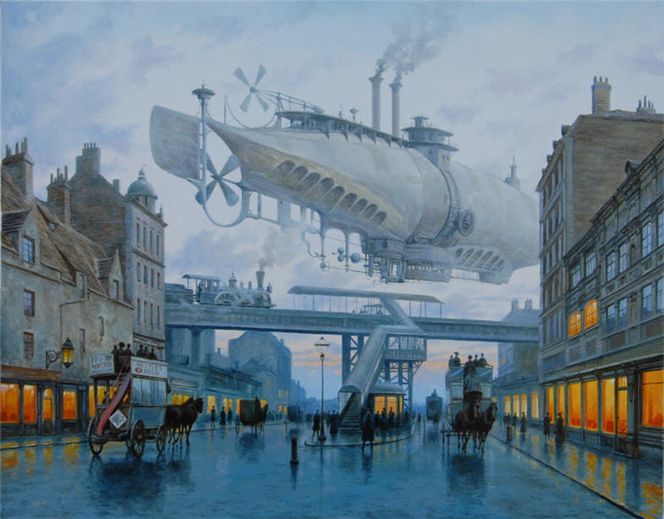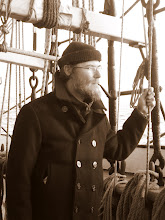To Fly Amongst the Clouds
 |
| Heavenly Nautilus by *voitv |
In the
previous articles in this series I talked about some of the ways that airship flight was controlled and the constraints that those ways imposed on flight duration. With the fantastically powerful energy source at the heart of our airship, I have concluded that using steam as the lifting gas essentially eliminates those constraints.
Besides, what better steampunk airship could we have than one that flies and is propelled using steam!
Later in this series I will attempt some calculations, to do a kind of "reality check", for the overall design. However to make sure that I wasn't too far off base, I did some quick calculations using the specs of the Hindenburg to see if steam lifting gas would result in useful lift. For an airship the size and dead weight of the Hindenburg, steam does indeed allow a small payload. You may recall that my buddy Grant's calculations had shown that in order to fly it would have to be 25% larger. But she was saddled with passenger accommodations and infrastructure to handle 40 or more people and their baggage, and since our airship is a military/exploratory one, not a commercial passenger ship, we have a lot of weight that can be re-allocated to our power and propulsion systems.
In a conventional gas filled airship the static lift system is independent of the propulsion. In the case of the great rigid airships like the Graf Zeppelin or Hindenburg, the lift was provided by hydrogen and the propulsion by diesel engines. In our case, courtesy of our power source, we can unify these systems with the attendant benefits
I discussed last time.
So how would this work in practice?
First I'll talk a bit about one way to make use of our power source to handle both lift and propulsion. Then I'll discuss a way to bring the power out to the propellers so we can begin our grand voyage. In my next post in this series I'll talk about how all this can be laid out in the hull and perhaps what form that hull will take.
Power Core
At the heart of our airship is the core, a dense block of "something" generating very large amounts of heat. (Personally I prefer to treat this core as a fission type nuclear reactor.) Since for our purposes it is our one major fantastical element, we don't have to deal with the pesky details of how it actually generates so much heat. We do however, need to deal with the practicalities of using it.
To keep things simple the core is either an "on or off", "feast or famine", deal. Once running this core continues to generate heat, whether we need it or not, therefore cooling of the core is a priority. The core is mounted in the center of a large tank of water. Thermosyphoning of the tank water around the core, where it is turned into low pressure steam, carries away this heat. This steam is used as our lift gas. In flight, we only need to generate steam to balance that which is condensed and collected from the gas bags inside the hull. This will not be enough to prevent overheating of the core, so a large radiator ,or condenser, is mounted on the top of the hull to condense any excess steam. This radiator is a primary structural component making up a significant portion of area of the hull itself. The radiator is air cooled, sending excess heat to the atmosphere.
In the event that the hull condenser cannot handle the excess steam, or in case of an emergency, steam will be sent directly to the atmosphere through a couple of elegant funnels on the upper hull. (Just cause it looks so damn cool.

)
In practice the Chief Engineer (me) and his staff would constantly monitor the heat balance of the main tank, along with the balance of lift steam and condensate reboil, directing excess steam to the condenser as required to keep things stable.
The main tank also serves to shield our crew from any adverse effects of the core itself. Water is a good shield for ionizing radiation. Two meters of water is sufficient to handle the gamma ray flux of a typical spent fuel rod from a modern reactor for example.
Power Generation
My proposal is for our airship to use a Tesla type electrical power system to drive its main propulsion engine. This power is generated in the engine room by the use of a similar system to that found in a modern nuclear reactor.
Given the very large amount of heat being produced continuously, the interior of the core itself is much hotter than its surface. A coil of steel pipes built into the structure of the core when it is made, carries a dense mineral oil into the heart of the core. Here the oil picks up the intense heat, and being under very high pressure, does not boil but remains liquid itself. This high pressure, very hot, oil is directed to a more or less conventional boiler outside the main tank. Here it is used to boil water, supplied from the main tank, to make steam. This steam is used to run a high speed turbine in the engine room. Exhaust steam from the turbine is directed to the hull condenser and thence back to the main tank.
Why not have water in the coil and simply flash it into steam directly?
To keep things simple. If the coil and boiler are arranged and sized correctly, no mechanical pumps are required to maintain the fluid flow through the core, and therefore the heat flow to the boiler. The density effects of temperature will cause the oil to flow in the loop. We want to minimize the amount of things that can fail INSIDE, or close to, the dangerous confines of the main tank near the core. Also it is likely that the fluid used in the loop will become dangerous (radioactive?) as a result of its close exposure to the core. With no mechanical pumps in the loop, there is no need to open the piping for repair or maintenance with the risk of exposure to any contaminated fluid.
The turbine is connected to one of
Tesla's high powered AC generators. This power is used to run the main propulsion systems.
Propulsion
Tesla's wireless power transmission system, a kind of tuned resonance, is used to transfer this power to the main engine without wires. The engine drives large counter rotating props at the stern of the airship. These props, by counter rotating, do not induce any rotational torque on the hull. A similar system is used to drive water torpedoes.
Auxiliary engines and propellers are mounted on the hull for use in maneuvering at low speeds during takeoff and landing. These engines also receive their power via Tesla's wireless system.
A side benefit to using Tesla's power system is that lighting and auxiliary power can be taken from the same system without the use of wires, thus helping to minimize weight.
The core gives us both lift and power for propulsion. There are no mechanical pumps necessary to control the primary system, minimizing the points of failure when we are far from our base. With such power at our command we can truly fly amongst the clouds, traveling the world in the search of adventure and in service of Her Majesty, HUZZAH!
Join me next time for some more details of how all this fits together within the airship's hull. An engineer's eye view if you will.
Keep your sightglass full, your firebox trimmed and your heat balance stable!
KJ
Click here for the next article in the series.
You can follow the full design thread by clicking on the tag
"Flight Engineer".






